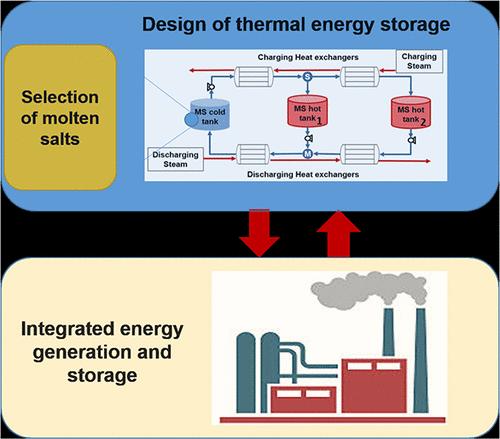High-Temperature Thermal Energy Storage: Process Synthesis, Material Selection, and Optimal Integration with a Power Plant
IF 3.9
3区 工程技术
Q2 ENGINEERING, CHEMICAL
引用次数: 0
Abstract
High-temperature thermal storage (HTTS), particularly when integrated with steam-driven power plants, offers a solution to balance temporal mismatches between the energy supply and demand. However, a simple HTTS design is inefficient and sometimes is infeasible, as the design does not achieve the same quality of discharged energy due to the loss of degree-of-superheating. More complex HTTS design and operation face challenges due to time-varying generation, interconnected storage cycles, the presence of nonlinear phase changes for both latent and sensible heat transfer, and the need for optimal selection of storage medium. We present a systematic optimization approach, utilizing an HTTS process superstructure representation and a mixed-integer nonlinear programming (MINLP) model, to address these challenges. This approach allows for the synthesis and integration of optimal HTTS designs, considering various process configurations and molten salts as storage medium. Case studies for HTTS design and integration with natural gas combined cycle (NGCC) power plants demonstrate that charging and discharging conditions significantly influence the round-trip efficiency (RTE) and the levelized cost of energy storage (LCOS). While integrating HTTS with steam turbines can achieve a high RTE, it increases the LCOS and the complexity of the HTTS design. Nonetheless, HTTS offers lower LCOS compared to stand-alone thermal storage systems. Among design options, a three-cycle HTTS system, utilizing liquid sensible heat, latent heat, and vapor sensible heat, achieves the highest RTE but may not always be cost-optimal. The selection of molten salt further affects RTE and LCOS, highlighting the trade-offs between the efficiency- and economics-based design objectives. The findings underscore the potential of HTTS in enhancing the ramping capacity and distributed storage capabilities of steam power plants, but emphasize that technological and economic feasibility must guide integration strategies.

高温热能储存:工艺合成、材料选择及与电厂的最佳整合
高温储热(HTTS),特别是当与蒸汽驱动发电厂集成时,提供了平衡能源供需之间时间不匹配的解决方案。然而,简单的HTTS设计效率低下,有时是不可行的,因为由于过热度的损失,设计无法达到相同的排放能量质量。更复杂的HTTS设计和运行面临着时变发电、互联存储周期、潜热和显热传递存在非线性相变以及存储介质优化选择的挑战。我们提出了一种系统的优化方法,利用HTTS过程上层结构表示和混合整数非线性规划(MINLP)模型来解决这些挑战。考虑到各种工艺配置和熔盐作为存储介质,这种方法允许综合和集成最佳HTTS设计。HTTS与天然气联合循环(NGCC)电厂的设计和集成案例研究表明,充放电条件对HTTS的往返效率(RTE)和储能平准化成本(LCOS)有显著影响。将HTTS与汽轮机集成可以获得较高的RTE,但增加了LCOS和HTTS设计的复杂性。尽管如此,与独立的储热系统相比,HTTS的LCOS更低。在设计方案中,利用液体显热、潜热和蒸汽显热的三循环HTTS系统实现了最高的RTE,但可能并不总是成本最优。熔盐的选择进一步影响RTE和LCOS,突出了基于效率和经济的设计目标之间的权衡。研究结果强调了HTTS在提高蒸汽发电厂的爬升能力和分布式存储能力方面的潜力,但强调技术和经济可行性必须指导整合战略。
本文章由计算机程序翻译,如有差异,请以英文原文为准。
求助全文
约1分钟内获得全文
求助全文
来源期刊

Industrial & Engineering Chemistry Research
工程技术-工程:化工
CiteScore
7.40
自引率
7.10%
发文量
1467
审稿时长
2.8 months
期刊介绍:
ndustrial & Engineering Chemistry, with variations in title and format, has been published since 1909 by the American Chemical Society. Industrial & Engineering Chemistry Research is a weekly publication that reports industrial and academic research in the broad fields of applied chemistry and chemical engineering with special focus on fundamentals, processes, and products.
 求助内容:
求助内容: 应助结果提醒方式:
应助结果提醒方式:


